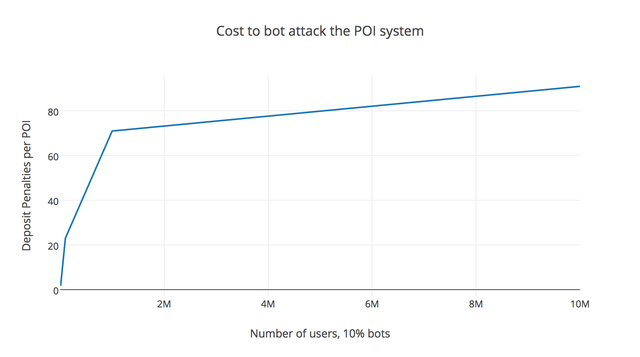
The anti-bot deposits increase the cost of attacking the POI network. The bots need to control a majority of a group to be able to verify one another, the pseudonym events use a point-system where 3 nyms always win over 2 nyms and over 1 nym, so for every group bots control, there would be lots of 1 and 2 account groups that they would loose their deposit in.
The cost to attack the POI network can be measured in depositPenaltiesPerPOI, the deposits for all bot accounts that end up in groups that are not under the bots control. This cost would have to exceed to value of a POI, if they are to prevent attacks.
If POIs are used for crypto basic income, for example swarm redistribution, and a basic income is around $1111, then depositPenaltiesPerPOI * depositSize would need to be higher than a basic income of $1111.
The ratio of groups with a majority of bots seems to decrease when the total number of users increases, if the percentage of bots is fixed.

Running a couple of tests,
int groupSize = 5;
int majority = 3;
with different population sizes, int population, and
int bots = population / 10;
int numGroups = population / groupSize;
int groups[numGroups];
int groupControlled[numGroups];
int groupsControlledByBots = 0;
and assigning the bots into groups by random,
int rand_max = 2147483647;
int denominator = rand_max / numGroups;
int a;
for( a = 0; a < bots; a = a + 1 ){
int groupNumber = rand() / denominator + 1;
groups[groupNumber] += 1;
if(groupControlled[groupNumber] == 0) {
if( groups[groupNumber] > majority ) {
groupsControlledByBots += 1;
groupControlled[groupNumber] = 1;
}
}
}
gave the distribution in the graph above, here it is again,

So if I understand this your saying an attack on a PoI setup would be possible but not profitable?
Downvoting a post can decrease pending rewards and make it less visible. Common reasons:
Submit